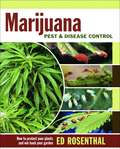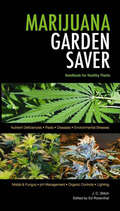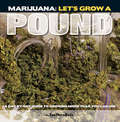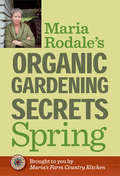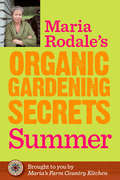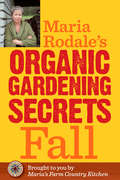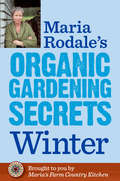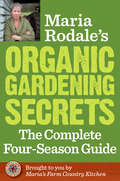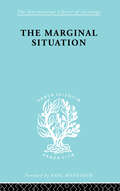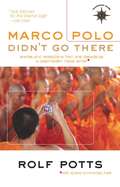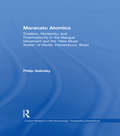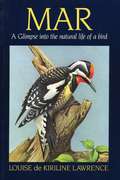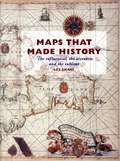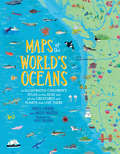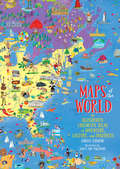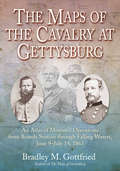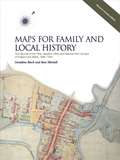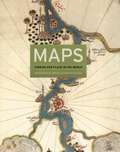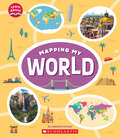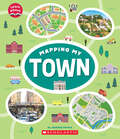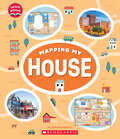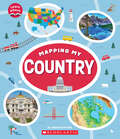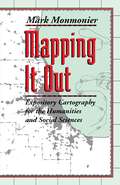- Table View
- List View
Marijuana Pest and Disease Control
by Ed Rosenthal Kathy ImbrianiA wide range of pests, diseases, and nutrient deficiencies can zap the vitality of any cannabis garden. Inexperienced gardeners often rely on pesticides that are not registered for edibles, as well as other harmful or ineffective techniques that can render plants unusable. This resourceful guide comes to the rescue, showing gardeners how to win back a garden and nurture plants to their full potential, using safe, organic, and integrated pest management techniques. In addition to providing readers with the know-how to get their plants healthy, Marijuana Pest and Disease Control highlights design and garden practices to prevent future infections. Author Ed Rosenthal gears the book to gardeners at every level of experience and in any growing situation from indoor, outdoor, and greenhouse to hydro and terrace gardens. Extensive color photographs and illustration help identify the exact problem.
Marijuana Pest and Disease Control
by Ed Rosenthal Kathy ImbrianiA wide range of pests, diseases, and nutrient deficiencies can zap the vitality of any cannabis garden. Inexperienced gardeners often rely on pesticides that are not registered for edibles, as well as other harmful or ineffective techniques that can render plants unusable. This resourceful guide comes to the rescue, showing gardeners how to win back a garden and nurture plants to their full potential, using safe, organic, and integrated pest management techniques. In addition to providing readers with the know-how to get their plants healthy, Marijuana Pest and Disease Control highlights design and garden practices to prevent future infections. Author Ed Rosenthal gears the book to gardeners at every level of experience and in any growing situation from indoor, outdoor, and greenhouse to hydro and terrace gardens. Extensive color photographs and illustration help identify the exact problem.
Marijuana Garden Saver: Handbook for Healthy Plants
by Ed Rosenthal J. C. StitchUtilizing a handy, field-guide style, this book is divided into five sections by problem type: Pests, Diseases, Environmental Stresses, Nutrient Deficiencies, and Controls. Problems are alphabetized within each section and identified in full-color photographs. A quick overview of the problem and likely causes is followed by the author's recommended fast and easy solution.
Marijuana Garden Saver
by Ed Rosenthal J. C. StitchUtilizing a handy, field-guide style, this book is divided into five sections by problem type: Pests, Diseases, Environmental Stresses, Nutrient Deficiencies, and Controls. Problems are alphabetized within each section and identified in full-color photographs. A quick overview of the problem and likely causes is followed by the author's recommended fast and easy solution.
Marijuana: Let's Grow a Pound
by SeemorebudsWant to grow more marijuana than you can smoke? Let's Grow a Pound is an easy to follow day-by-day guide that will help you grow a bigger harvest than you ever imagined possible.SeeMoreBuds, author of the hit Marijuana Buds For Less, has taken all the guesswork out of growing indoors and harvesting more than a pound of marijuana in under three months. Each of the 73 days it takes to get to a bountiful harvest is described and demonstrated with beautiful full-color photographs. The equipment needed, set up, and each stage of growing, care taking, hydrating, feeding and identifying and dealing with potential problems are all here.This book is a must-have for anyone even interested in growing the finest marijuana around without spending an arm and a leg. The methods demonstrated in the book are guaranteed to lead a grower to success, whether they are a complete novice or an experienced "greenthumb" looking for a better way to grow.Let's Grow A Pound is published and edited by world-famous marijuana cultivator Ed Rosenthal.
Maria Rodale's Organic Gardening Secrets: Spring
by Maria RodaleMaria Rodale shares her top organic gardening secrets season-by-season in a guide that offers straight-forward, easy-to-follow gardening basics so that youcan enjoy a beautiful, bountiful, organic garden all year long!Spring explainshow to prepare for, plan, and plant your garden, as well as how to start your own seeds, improve soil health, create the best compost, build a raised bed, and harvest early crops.
Maria Rodale's Organic Gardening Secrets: Summer
by Maria RodaleMaria Rodale shares her top organic gardening secrets season-by-season in a guide that offers straight-forward, easy-to-follow gardening basics so that youcan enjoy a beautiful, bountiful, organic garden all year long!In Summer, you will find the best chemical-free bug solutions, easy organic weeding strategies, sustainable watering techniques, and simple, effective ways to boost your yield organically.
Maria Rodale's Organic Gardening Secrets: Fall
by Maria RodaleMaria Rodale shares her top organic gardening secrets season-by-season in a guide that offers straight-forward, easy-to-follow gardening basics so that youcan enjoy a beautiful, bountiful, organic garden all year long!Fall explains learn how to extend your growing season into winter; pick out bulbs, trees, and shrubs; add color to your garden, and preserve your garden's bounty for winter. Maria also shares her very own recipes for a Thanksgiving feast.
Maria Rodale's Organic Gardening Secrets: Winter
by Maria RodaleMaria Rodale shares her top organic gardening secrets season-by-season in a guide that offers straight-forward, easy-to-follow gardening basics so that youcan enjoy a beautiful, bountiful, organic garden all year long!Winter explains how to prepare for and plan next year's garden, order the best seeds for your needs, and start seedlings indoors. Plus, Maria shares her favorite winter comfort food recipes!
Maria Rodale's Organic Gardening Secrets: The Complete Four Season Guide
by Maria RodaleMaria Rodale shares her organic gardening secrets in a season-by-season guide that offers straight-forward, easy-to-follow gardening basics so that anyone can enjoy a beautiful, productive, organic garden all year long. In the spring, learn how to prepare for and plan your garden in order to ensure a bountiful 4-season garden, as well as how to improve your soil health, create the best compost, and harvest early crops. In the summer, find the best chemical-free bug solutions, easy organic weeding strategies, sustainable watering techniques, and simple effective ways to boost your yield organically. In the fall, learn how to extend your growing season into winter; pick out bulbs, trees, and shrubs; add color to your garden, and preserve your garden's bounty for winter. Maria also shares her very own recipes for a Thanksgiving feast. And in winter, learn how to plan for next year's garden, order the best seeds for your needs, and start seedlings indoors. Plus, Maria shares her favorite winter comfort food recipes.
Marginal Situation Ils 112 (International Library of Sociology)
by H. E. Dickie-ClarkFirst published in 1998. Routledge is an imprint of Taylor & Francis, an informa company.
Marco Polo Didn't Go There
by Rolf PottsMarco Polo Didn't Go There is a collection of rollicking travel tales from a young writer USA Today has called "Jack Kerouac for the Internet Age." For the past ten years, Rolf Potts has taken his keen postmodern travel sensibility into the far fringes of five continents for such prestigious publications as National Geographic Traveler, Salon.com, and The New York Times Magazine. This book documents his boldest, funniest, and most revealing journeys-from getting stranded without water in the Libyan desert, to crashing the set of a Leonardo DiCaprio movie in Thailand, to learning the secrets of Tantric sex in a dubious Indian ashram.Marco Polo Didn't Go There is more than just an entertaining journey into fascinating corners of the world. The book is a unique window into travel writing, with each chapter containing a "commentary track"-endnotes that reveal the ragged edges behind the experience and creation of each tale. Offbeat and insightful, this book is an engrossing read for students of travel writing as well as armchair wanderers.
Maracatu Atomico: Tradition, Modernity, and Postmodernity in the Mangue Movement of Recife, Brazil (Current Research in Ethnomusicology: Outstanding Dissertations #Vol. 3)
by Philip Galinsky"Maracatu Atômico" is the first academic work to investigate the mangue movement, one of Brazil's most vital pop culture trends of the last thirty years, and the related "new music scene" of Northeast Brazil. Contending with the widespread poverty and social problems, mangue places a renewed value on the local environment and its myriad folk traditions while embracing modern, global pop influences and technology. The book provides historical and ethnographic accounts of the movement, analyzes salient examples of folk and pop fusion music, and enters recent debates about postmodernity, globalization, and "world music" in an attempt to understand better how local musicians in one "Third World" region interact within a more global cultural system.
Mar: A Glimpse into the Natural Life of a Bird
by Louise De Lawrence"Writing with uncanny skill, Louise de Kiriline Lawrence leads us gently into the world of birds. Her perception, intuition and experience give her insights that she here freely shares with us all. "I knew this remarkable lady for years, and had previously read her Mar, but on re-reading it, I was struck with the sensitive, magical way she reveals the behaviour of Yellow-bellied Sapsuckers. "At her doorstep, at almost everyone’s doorstep, there is a wondrous, beautiful world, if we will only be patient and observant. In Mar, Mrs. Lawrence shows us the way."Naturalists, birders, aspiring ornithologists, scientists, all should take time to read Mar." - Robert W. Nero, Author of The Great Gray Owl and Redwings "Mar is a glimpse into the natural life of a woodpecker – a yellow-bellied sapsucker – in two nesting seasons, as it interacts with its mate and other forest creatures. "The narrative, deceptively simple, consolidates a lifetime of careful observation and imaginative research. It should appeal to all birdwatchers, novice or expert."- Maureen Johnson, The Ottawa Citizen
Maps That Made History: The Influential, the Eccentric and the Sublime
by Lez SmartFew people can resist the appeal of old maps and plans. Even in these days of disposable mapping - from satellite navigation to customized road directions at the click of a mouse - the historical map continues to present a unique perspective on our changing world. Here we explore 25 glorious examples. The emphasis is on the story behind the map: what it reveals about its creator and users, from the first explorers to the railway builders. This thought-provoking collection features maps that chart societies as well as land, sea, and skies; maps that have influenced and inspired; and perhaps most revealing of all, maps that misrepresent.
Maps of the World's Oceans: An Illustrated Children's Atlas to the Seas and all the Creatures and Plants that Live There
by Enrico Lavagno Angelo MojettaThis lavishly illustrated, fact-filled atlas--a follow-up to Maps of the World--allows children to discover the fascinating and mysterious world below sea level with links to explore even further on computers and tablets. Covering every ocean and major sea in the world, Maps of the World's Oceans is a vibrant and comprehensive atlas that children of all ages will love to explore. The dozens of colorful, detailed maps are filled with hundreds of illustrated icons highlighting creatures that inhabit the waters of the world from deep-ocean sharks to sea birds that rely on the water to survive. Also featured are vital vegetation, submerged shipwrecks, and icons representing the myths and legends of the various peoples who supposedly lived by the seas. Along the surface, readers will explore ports, lighthouses, famous explorers and voyages, old navigation secrets, and more. Flip the next page from any map and the corresponding icon key explains why these fish, animals, various organisms and more are so vital to the oceans and the seas - and therefore the world. Young readers will learn about waves and tides, currents and oceanic ridges, and more giving them a complete look at the world's waters. Each map includes a link allowing kids to download a version of them on computers and tablets to explore even further. Captivating and comprehensive, Maps of the World's Oceans will entice even the most reluctant young explorer.
Maps of the World: An Illustrated Children's Atlas of Adventure, Culture, and Discovery
by Enrico Lavagno Sacco And VallarinoA lavishly illustrated, fact-filled, oversized atlas that allows children to discover the world without leaving their home. Covering every continent, country, even outer space, MAPS OF THE WORLD is a vibrant and comprehensive atlas that children of all ages will love to explore. The dozens of colorful, detailed maps are filled with charming, educational icons representing the aboriginal people in Australia, giant tortoises in the Galapagos, the Gold Rush in California, traditional dress in Mali, and even James Bond in England. Flip the next page in the book, and the corresponding icon key explains hundreds of these cultural, environmental, and societal illustrations. Organized by continent, the atlas also includes details on populations, language, agricultural, politics, and other bite-size facts. Each map includes a link allowing kids to download a version of them on computers and tablets to explore even further. Captivating and comprehensive, MAPS OF THE WORLD will entice even the most reluctant young explorer.
The Maps of the Cavalry at Gettysburg: An Atlas of Mounted Operations from Brandy Station through Falling Waters, June 9–July 14, 1863 (Savas Beatie Military Atlas Series)
by Bradley M. GottfriedThe Maps of the Cavalry in the Gettysburg Campaign: An Atlas of Mounted Operations from Brandy Station Through Falling Waters, June 9 - July 14, 1863 continues Bradley M. Gottfried’s efforts to study and illustrate the major campaigns of the Civil War’s Eastern Theater. This is his seventh book in the ongoing Savas Beatie Military Atlas Series. The Maps of Gettysburg, Gottfried’s inaugural and groundbreaking atlas published in 2007, covered only a small portion of the cavalry’s actions during the seminal campaign. This book addresses that topic in-depth in a way that no other study has ever achieved. Gottfried covers the opening battle of the campaign at Brandy Station in detail, followed by the actions at Aldie, Middleburg, and Upperville, where Jeb Stuart’s cavalry successfully halted Alfred Pleasonton’s probes toward the Blue Mountain passes in an effort to determine the location of Robert E. Lee’s army. The movements toward Gettysburg are covered in a series of maps, including the actions at Westminister, Hanover, and Hunterstown. The five major actions on July 2-3 at Gettysburg take up a considerable portion of the book and include the fight at Brinkerhoff Ridge, and four more on July 3 (Stuart against David Gregg northeast of the town, Wesley Merritt’s fight along Emmitsburg Road, Judson Kilpatrick’s actions near the base of Big Round Top, and Grumble Jones’s near-destruction of the 6th U.S. Cavalry near Fairfield). The cavalry also played a vital role during Lee’s retreat to the Potomac River. The numerous fights at Monterrey Pass, Smithfield, Boonsboro, Funkstown, and Hagerstown were of critical importance to both sides and are covered in detail. The book concludes with the fight at Falling Waters and ends with an epilogue recounting events occurring in Virginia through the end of July. The Maps of the Cavalry in the Gettysburg Campaign plows new ground by breaking down the entire campaign into sixteen map sets or “action sections,” enriched with 82 detailed full-page color maps. These cartographic originals bore down to the regimental and battery level, and include the march to and from the battlefield and virtually every significant event in between. At least two—and as many as ten—maps accompany each map set. Keyed to each piece of cartography is a full-facing page of detailed text describing the units, personalities, movements, and combat (including quotes from eyewitnesses) depicted on the accompanying map, all of which make the cavalry actions come alive. This presentation allows readers to easily and quickly find a map and text on virtually any portion of the campaign. Serious students will appreciate the extensive and authoritative endnotes and complete order of battle, and take it with them on trips to the battlefields. A final bonus is that the maps unlock every other book or article written on any aspect of the cavalry’s actions during this important campaign. Perfect for the easy chair or for stomping the hallowed grounds, The Maps of the Cavalry in the Gettysburg Campaign is a seminal work that belongs on the bookshelf of every serious and casual student of the battle.
Maps for Family and Local History (2nd Edition): Records of the Tithe, Valuation Office and National Farm Surveys of England and Wales, 1836-1943
by William Foot Geraldine Beech Rose MitchellMaps for Family and Local History shows how three great land surveys can provide information on ancestral homes, as well as fascinating historical snapshots of specific areas. Covering 1836 to 1943, the Tithe, Valuation Office, and National Farm Surveys provide a wealth of information on rural and urban localities, on dwellings, settlements, and landscapes as well as the status of householders. The text gives the rationale behind the surveys and covers each in detail. Fully updated by map experts from The National Archives, this illustrated guide is the perfect companion to researching those maps.
Maps: Finding Our Place in the World
by James R. Akerman Robert W. Karrow Jr.In today's world where location, direction, and guidance are essential components of our daily lifestyle, digital maps are transforming the way we use such information and helping us find our way to people, places, and opportunities more easily and safely than ever before.
Mapping My Town (Learn About)
by Jeanette FerraraA perfect first introduction to maps and map skills for young readers!Families can live in all kinds of towns. From urban and suburban, to rural communities, towns can look different but still have a lot in common. Learn how to use map features like a key, compass rose, and a scale to answer questions about direction, measurement, and symbols. Look at photos of different types of towns and use the maps inside the book to navigate and compare what is the same and what is different about living in a city, suburb, or farming community. At the end, you will be ready to draw a map of your own town. All this and more in Mapping My Town!ABOUT THIS SERIES: Starting from their bedroom, and moving to their home, street, neighborhood, town, state, country, continent, and finally, planet, children will gain a whole new understanding of their place in the world with this engaging picture book series. With illustrated maps drawn at different scales and vibrant photographs throughout to illustrate real locations, children will learn about map features, how to read maps and answer questions, and how to draw their own maps. Maps are everywhere and understanding them is key to navigating our world. With this brand new and original four-book series, children will expand their role as citizens.
Mapping My Country: (learn About) (Learn About)
by Jeanette FerraraA perfect first introduction to maps and map skills for young readers!There are families living in countries across the Americas and all around the world. From Canada, the United States, and Mexico to Central America, countries can look very different but still have a lot in common. Learn how to use map features like a key, compass rose, and a scale to answer questions about direction, measurement, and symbols. Look at photos of different countries, and use the maps inside the book to navigate and compare what is the same and what is different between them. At the end, you will be ready to draw a map of your own country. All this and more in Mapping My Country!ABOUT THIS SERIES:Starting from their bedroom, and moving to their home, street, neighborhood, town, state, country, continent, and finally, planet, children will gain a whole new understanding of their place in the world with this engaging picture book series. With illustrated maps drawn at different scales and vibrant photographs throughout to illustrate real locations, children will learn about map features, how to read maps and answer questions, and how to draw their own maps. Maps are everywhere and understanding them is key to navigating our world. With this brand new and original four-book series, children will expand their role as citizens.
Mapping It Out: Expository Cartography for the Humanities and Social Sciences
by Mark MonmonierWriters know only too well how long it can take--and how awkward it can be--to describe spatial relationships with words alone. And while a map might not always be worth a thousand words, a good one can help writers communicate an argument or explanation clearly, succinctly, and effectively. In his acclaimed How to Lie with Maps, Mark Monmonier showed how maps can distort facts. In Mapping it Out: Expository Cartography for the Humanities and Social Sciences, he shows authors and scholars how they can use expository cartography--the visual, two-dimensional organization of information--to heighten the impact of their books and articles. This concise, practical book is an introduction to the fundamental principles of graphic logic and design, from the basics of scale to the complex mapping of movement or change. Monmonier helps writers and researchers decide when maps are most useful and what formats work best in a wide range of subject areas, from literary criticism to sociology. He demonstrates, for example, various techniques for representing changes and patterns; different typefaces and how they can either clarify or confuse information; and the effectiveness of less traditional map forms, such as visibility base maps, frame-rectangle symbols, and complementary scatterplot designs for conveying complex spatial relationships. There is also a wealth of practical information on map compilation, cartobibliographies, copyright and permissions, facsimile reproduction, and the evaluation of source materials. Appendixes discuss the benefits and limitations of electronic graphics and pen-and-ink drafting, and how to work with a cartographic illustrator. Clearly written, and filled with real-world examples, Mapping it Out demystifies mapmaking for anyone writing in the humanities and social sciences. "A useful guide to a subject most people probably take too much for granted. It shows how map makers translate abstract data into eye-catching cartograms, as they are called. It combats cartographic illiteracy. It fights cartophobia. It may even teach you to find your way."--Christopher Lehmann-Haupt, The New York Times
